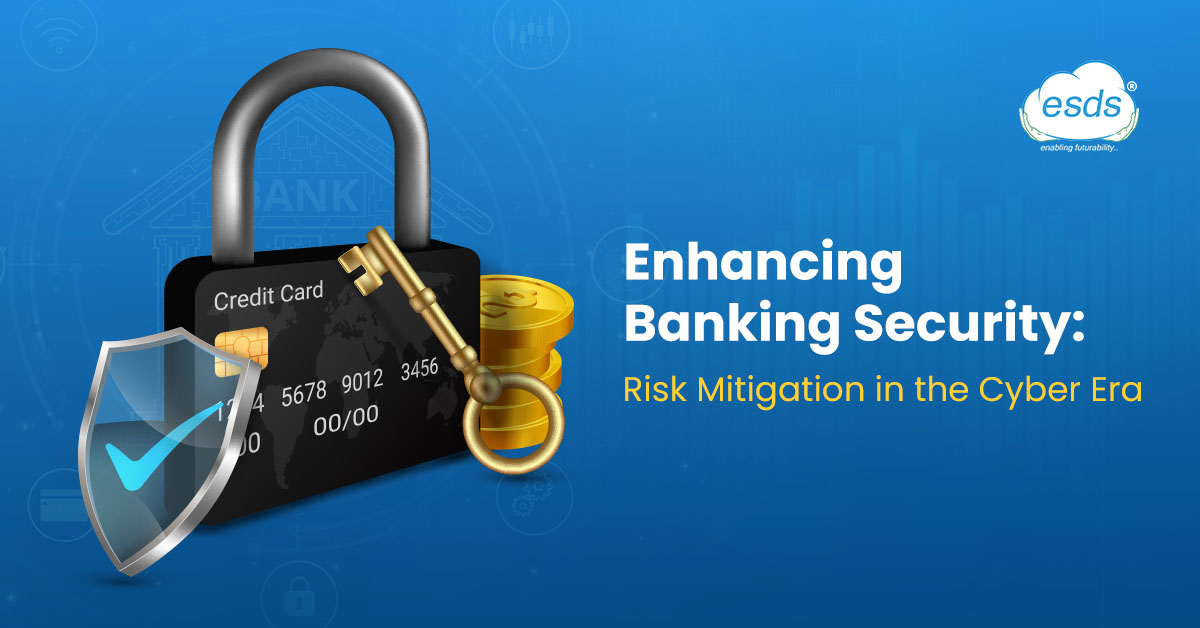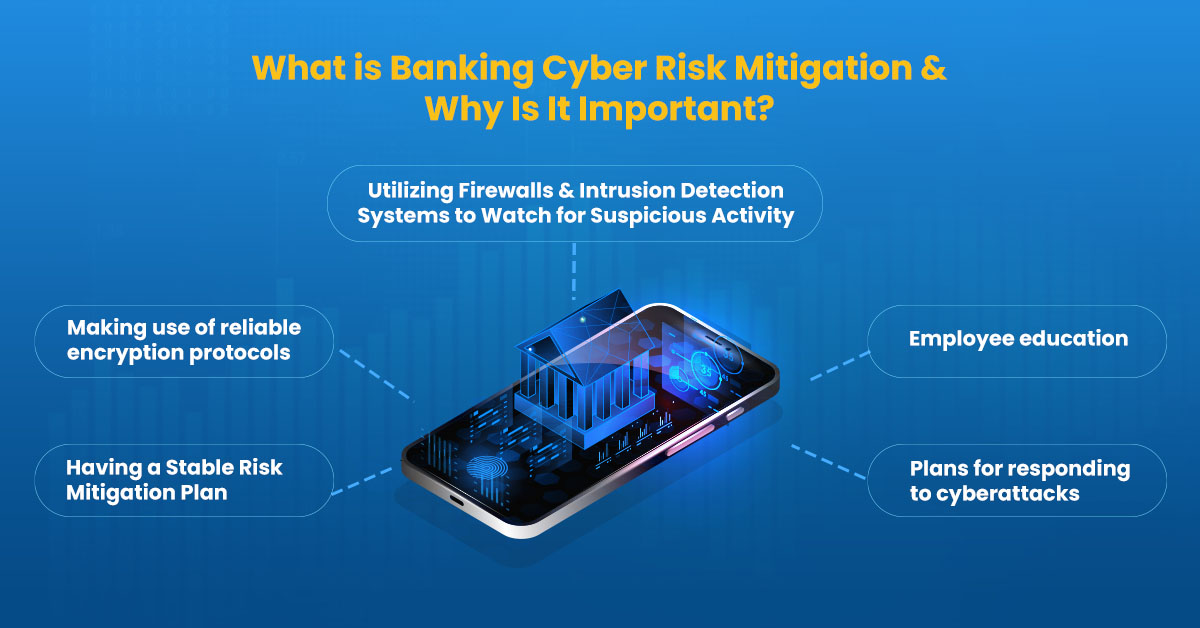Enhancing Banking Security: Risk Mitigation in the Cyber Era

It is well known that cybercriminals frequently target the banking industry. Cybercriminals aim to extort money, disrupt bank operations, and steal the vast amounts of valuable financial data that banks store. Banks and financial institutions must be the first to priorities cybersecurity and have a successful risk mitigation strategy given the rise of cybercrime and the potential for significant financial losses. Millions of dollars in losses and irreversible harm to the brand of the company are possible outcomes of a successful attack on a financial institution.
You’ve probably noticed a sign that says, “Your Security is Our Priority” when you’ve visited a bank. Thanks to this institution’s online data protection procedures, you feel confident that your money and personal information are secure. However, have you ever wondered what goes on in the background to make sure your bank is safe? Let’s look at this.
What is Banking Cyber Risk Mitigation & Why Is It Important?
Banks and other financial institutions are among the most susceptible to cyber dangers, as we have already mentioned. Risk identification, which can be accomplished through a risk assessment, is referred to as risk mitigation. The next step is to rank these hazards in order of importance for your particular firm. The next step is to decide which types of risk mitigation methods will work for you. These strategies will aid in risk monitoring, risk reduction, and risk mitigation. Or, to put it another way, risk mitigation in the financial sector is all about foreseeing potential threats and taking precautions to minimize them.
Risk mitigation is also crucial in terms of cybersecurity. Because banks store a wealth of important information, including personal and financial data, they are a top target for hackers.
Security and risk management in banking depend on anti-money laundering. Criminals who get unauthorized access to financial institutions in order to launder money from illicit sources or commit other financial crimes can be found, discouraged, and stopped with the help of AML. Banks are required to take reasonable care in locating and keeping track of their clients, transactions, and other operations in order to discover any suspicious conduct. In order to prevent cyberattacks and other criminal acts, banks must also make sure that their systems and processes are secure and robust.
Here are some essential risk mitigation measures that banks and other financial institutions implement to safeguard their vital infrastructure and their clients’ private information:

1. Having a Stable Risk Mitigation Plan
The following best practices are involved in risk mitigation:
Creating a workable framework for risk management should entail defining the bank’s risk appetite clearly, identifying and evaluating potential risks, monitoring risks, and having an efficient control mechanism.
Putting in place a framework for risk-based capital adequacy: To make sure the bank has enough capital to cover potential losses, a risk-based capital adequacy strategy is crucial. As part of this framework, risk categories should be defined, capital requirements should be determined, and capital adequacy should be measured.
Adopting a thorough risk management strategy: Banks should implement a thorough risk management strategy that spells out their approach to risk management, the duties of risk management employees, and the procedure for identifying, measuring, monitoring, and controlling risks.
Enhancing operational risk management: To ensure correct internal controls, effective and efficient operations, and the prevention of potential losses, banks should enhance their operational risk management procedures.
Internal audit should be strengthened by banks continuing to monitor, identify, and manage risks through internal audit processes. Internal audits ought to have enough power. ESDS provides comprehensive risk mitigation solutions that empower banks to establish stable and resilient defense against cyber-threats.
2. Making use of reliable encryption protocols
In the banking industry, robust encryption procedures refer to the use of safe encryption methods to safeguard sensitive data and transactions. ESDS employs industry-leading encryption protocols to ensure the confidentiality and integrity of sensitive data in the banking sector.
Encryption is the process of converting plain text into coded or jumbled text that only a person in possession of the right key can decipher to unlock. Strong encryption techniques are essential in banking for stabilizing the safety and reliability of the banking system.
3. Utilizing Firewalls & Intrusion Detection Systems to Watch for Suspicious Activity
Data leaks and cyberattacks are topics that frequently appear in the news. Banks defend themselves against these dangers by utilizing firewalls and intrusion detection systems. Between a bank’s internal network and the internet, a firewall acts as a kind of barrier. It can manage network traffic coming into and going out of it and filter out any undesired or dubious activity. It’s comparable to a club having a bouncer check IDs at the entry to verify that only authorized patrons enter.
Firewalls can be configured to prohibit specific traffic types, including incoming traffic from particular IP addresses and applications or protocols that might be used maliciously. ESDS deploys advanced firewalls and intrusion detection systems to actively monitor and detect any suspicious activity, bolstering the security posture of banks against potential threats.
4. Employee education
Social engineering strategies like phishing and pretexting are frequently used in cyberattacks. These assaults frequently prey on human weaknesses and dupe staff into disclosing private information or clicking on malicious links. By teaching staff members how to spot and report unusual activity, cybersecurity training for employees can aid in preventing these assaults.
By giving employees the information and skills to defend themselves and their company from cyber threats, cybersecurity training can help reduce these risks. This includes instruction on email security, data encryption, password security, and planning and responding to cyber incidents. ESDS solution experts are dedicated to providing comprehensive support, guiding banks through the implementation and management of cybersecurity solutions, ensuring they have the expertise and assistance they need to safeguard their operations effectively.
5. Plans for responding to cyberattacks
In the event that something unpleasant occurs in the middle of a flight, pilots are given a checklist that they must go through. They can follow this checklist’s instructions to immediately avoid danger and maintain control of the situation.
A comparable plan is a cyber-incident response plan. It includes a set of guidelines outlining what should be done in the event of a cybersecurity incident by the management team and the IT team. It enables them to mitigate the harm brought on by the occurrence, recover fast, and keep their consumers’ trust. In particular, it can significantly lessen the financial effects of an incident. The incident response plan, for instance, would detail methods for locating and containing the breach, contacting the impacted customers and the appropriate authorities, and preventing future breaches if a bank’s system was compromised and client data was stolen.
ESDS assists banks in developing and implementing robust incident response plans, ensuring swift and effective actions in the event of a cyberattack. Our experts provide timely guidance, technical expertise, and support to mitigate the impact of an attack and restore normal operations efficiently.
Final Reflections
At ESDS, we understand the unique challenges faced by banking institutions and are dedicated to providing cutting-edge solutions to safeguard their digital assets. With our elaborate suite of cybersecurity services, we empower banks to proactively identify and mitigate risks, ensuring the integrity, confidentiality, and availability of their sensitive data.
Partner with ESDS to bolster your cybersecurity posture, mitigate risks, and protect your organization’s reputation. Together, we aim for a secure future for the banking industry, safeguarding assets and ensuring the trust of customers in this ever-connected world.
- Why does your business need Endpoint Detection and Response (EDR)? - May 15, 2024
- Are your business endpoints completely secure? - March 26, 2024
- Is Colocation key to transforming your data center management strategy? - March 22, 2024
